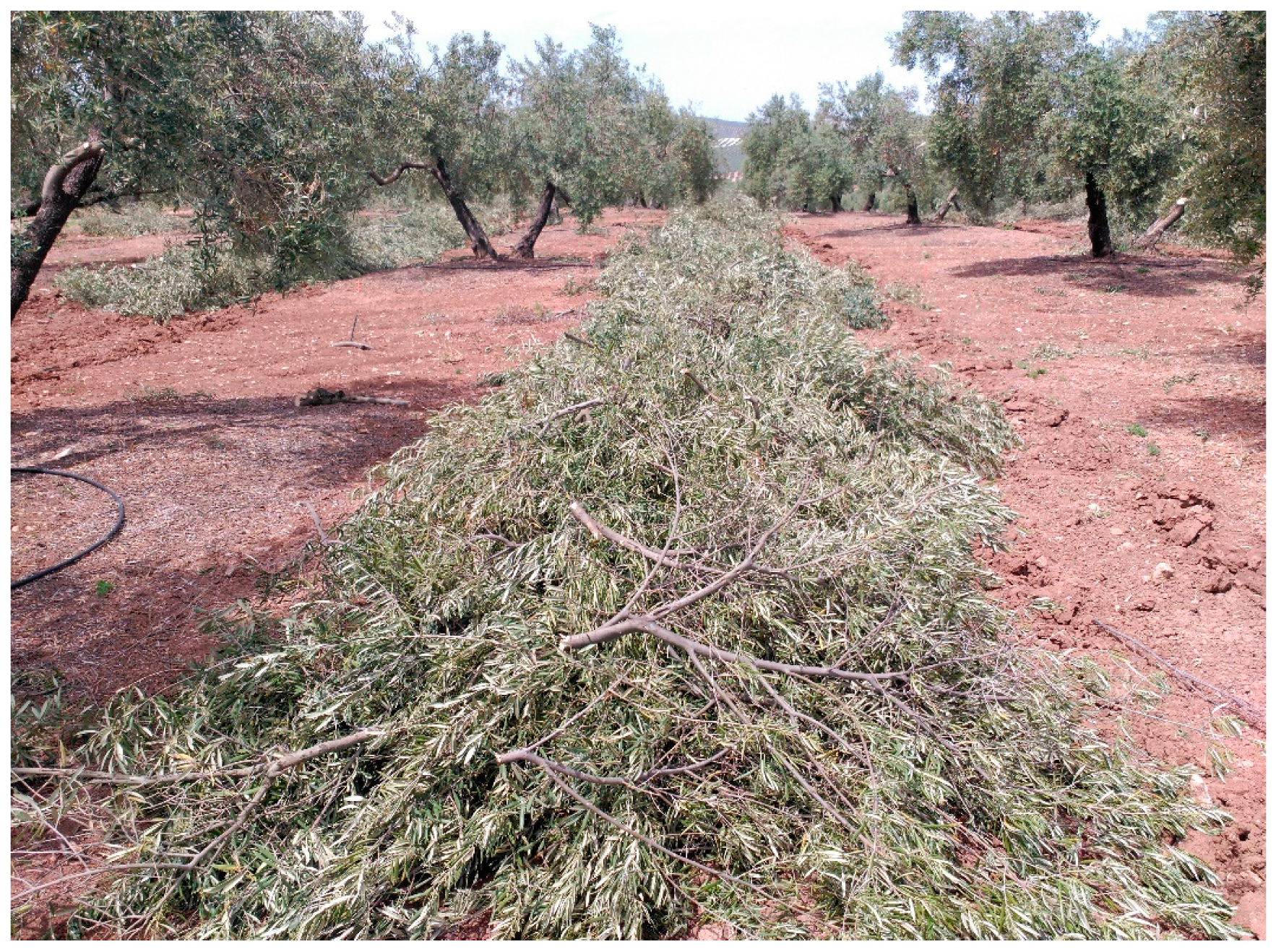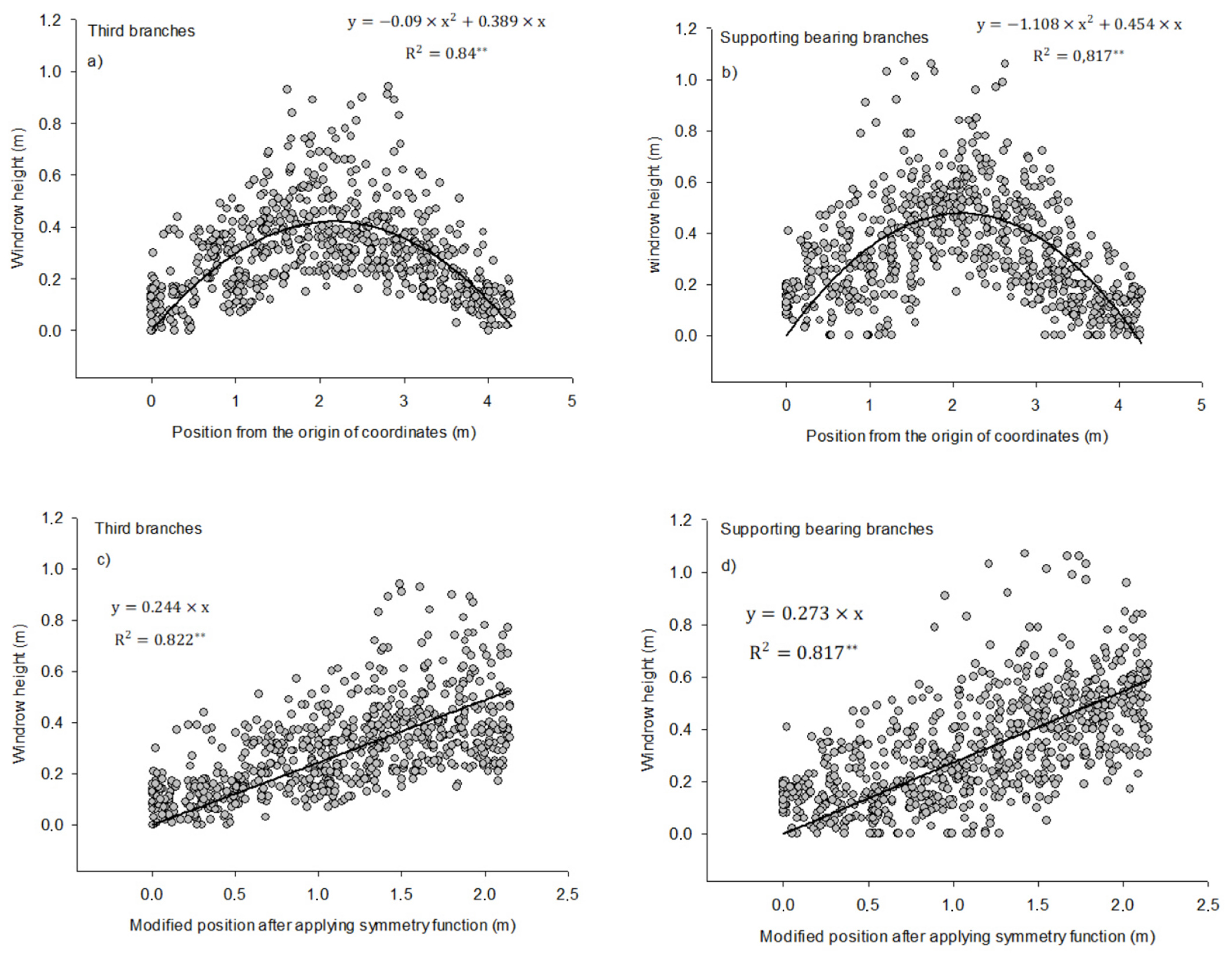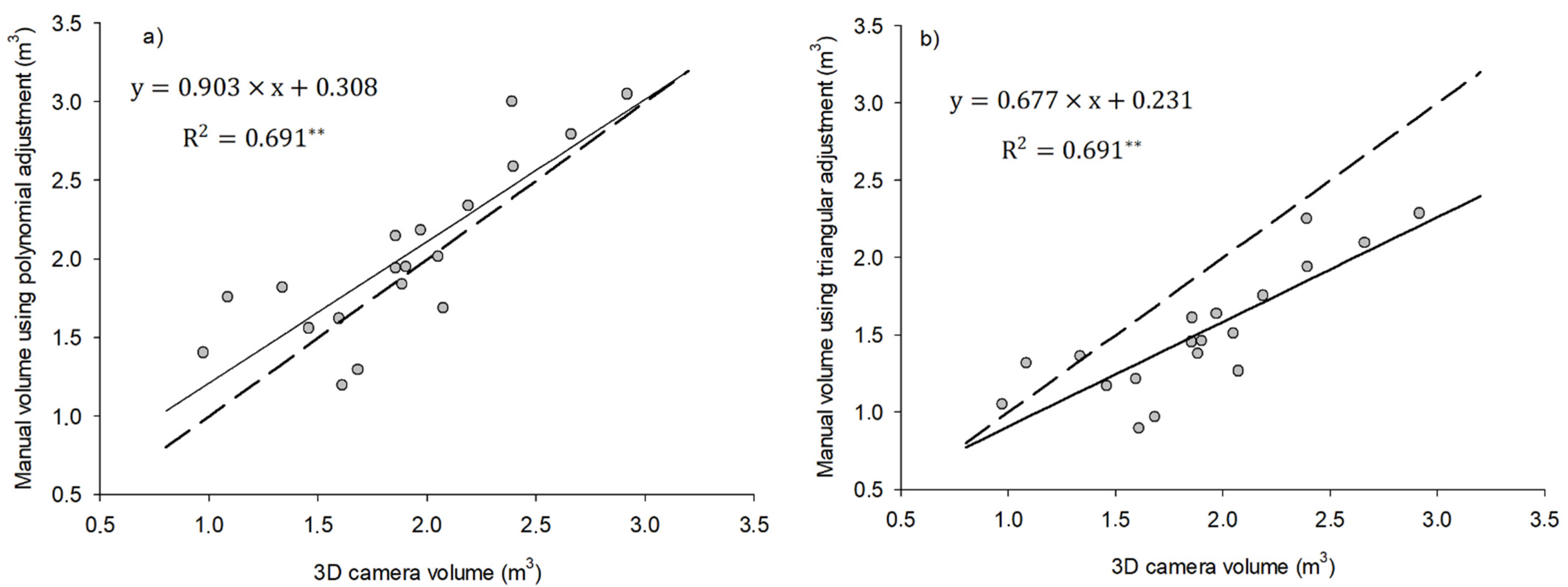Methodology for Olive Pruning Windrow Assessment Using 3D Time-of-Flight Camera
Abstract
1. Introduction
2. Materials and Methods
- Scaffold limbs: Branches adjoined to a tree trunk with a cut diameter over 0.12 m and fresh weight higher than 25 kg branch−1.
- Secondary branches: These branches usually adjoin scaffold limbs, have a cut diameter between 0.12 and 0.06 m and a fresh weight between 25 and 5 kg branch−1.
- Third branches: They could adjoin both scaffold limbs and secondary branches, and had a cut diameter between 0.06 and 0.03 m. For this branch category, fresh weight was between 5 and 1 kg branch−1.
- Supporting bearing branches: these branches supported the fruit-bearing branches, had a cut diameter between 0.03 and 0.015 m, and a fresh weight between 1 and 0.3 kg branch−1.
- Bearing branches: The fruit bearing branches, with very little wood, a cut diameter under 0.015 m, and a fresh weight lower than 0.3 kg branch−1.
3. Results
4. Discussion
5. Conclusions
Author Contributions
Funding
Institutional Review Board Statement
Informed Consent Statement
Data Availability Statement
Acknowledgments
Conflicts of Interest
References
- Análisis del Olivar a Nivel Mundial. Available online: https://www.interempresas.net/Grandes-cultivos/Articulos/302096-Analisis-del-olivar-a-nivel-mundial.html (accessed on 17 October 2020).
- Agricultural Production—Orchards. Available online: https://ec.europa.eu/eurostat/statistics-explained/index.php/Agricultural_production_-_orchards#Apple_trees (accessed on 18 February 2020).
- Aceite de Oliva. Available online: http://www.mapama.gob.es/es/agricultura/temas/producciones-agricolas/aceite-oliva-y-aceituna-mesa/aceite.aspx#para1 (accessed on 17 October 2020).
- Innolivar Lineas de Convenio. Available online: https://innolivar.es/ (accessed on 17 October 2020).
- Castillo-Ruiz, F.; Sola-Guirado, R.; Castro-Garcia, S.; Gonzalez-Sanchez, E.; Colmenero-Martinez, J.; Blanco-Roldán, G. Pruning systems to adapt traditional olive orchards to new integral harvesters. Sci. Hortic. 2017, 220, 122–129. [Google Scholar] [CrossRef]
- Acampora, A.; Croce, S.; Assirelli, A.; Del Giudice, A.; Spinelli, R.; Suardi, A.; Pari, L. Product contamination and harvesting losses from mechanized recovery of olive tree pruning residues for energy use. Renew. Energy 2013, 53, 350–353. [Google Scholar] [CrossRef]
- Vivaldi, G.A.; Strippoli, G.; Pascuzzi, S.; Stellacci, A.; Camposeo, S. Olive genotypes cultivated in an adult high-density orchard respond differently to canopy restraining by mechanical and manual pruning. Sci. Hortic. 2015, 192, 391–399. [Google Scholar] [CrossRef]
- Spinelli, R.; Picchi, G. Industrial harvesting of olive tree pruning residue for energy biomass. Bioresour. Technol. 2010, 101, 730–735. [Google Scholar] [CrossRef] [PubMed]
- Marti, B.V.; Fernández-González, E.; Cortés, I.L.; Salazar-Hernández, D. Quantification of the residual biomass obtained from pruning of vineyards in Mediterranean area. Biomass Bioenergy 2011, 35, 3453–3464. [Google Scholar] [CrossRef]
- Benyei, P.; Cohen, M.; Gresillon, E.; Angles, S.; Araque-Jiménez, E.; Alonso-Roldán, M.; Espadas-Tormo, I. Pruning waste management and climate change in Sierra Mágina’s olive groves (Andalusia, Spain). Reg. Environ. Chang. 2018, 18, 595–605. [Google Scholar] [CrossRef]
- Proietti, S.; Sdringola, P.; Regni, L.; Evangelisti, N.; Brunori, A.; Ilarioni, L.; Nasini, L.; Proietti, P. Extra Virgin Olive oil as carbon negative product: Experimental analysis and validation of results. J. Clean. Prod. 2017, 166, 550–562. [Google Scholar] [CrossRef]
- Iraldo, F.; Testa, F.; Bartolozzi, I. An application of Life Cycle Assessment (LCA) as a green marketing tool for agricultural products: The case of extra-virgin olive oil in Val di Cornia, Italy. J. Environ. Plan. Manag. 2013, 57, 78–103. [Google Scholar] [CrossRef]
- Repullo, M.; Carbonell-Bojollo, R.; Hidalgo, J.; Rodríguez-Lizana, A.; Ordóñez, R. Using olive pruning residues to cover soil and improve fertility. Soil Tillage Res. 2012, 124, 36–46. [Google Scholar] [CrossRef]
- Decree 371/2010, de 14 de septiembre, por el que se aprueba el Plan de Emergencia por Incendios Forestales de Andalucía y se modifica el Reglamento de Prevención y Lucha contra los Incendios Forestales aprobado por el Decreto 247/2001, de 13 de noviembre. Available online: http://www.juntadeandalucia.es/boja/2010/192/1 (accessed on 17 October 2020).
- Calatrava, J.; Franco, J.A. Using pruning residues as mulch: Analysis of its adoption and process of diffusion in Southern Spain olive orchards. J. Environ. Manag. 2011, 92, 620–629. [Google Scholar] [CrossRef]
- Bayano-Tejero, S.; Sola-Guirado, R.R.; Gil-Ribes, J.A.; Blanco-Roldán, G.L. Machine to machine connections for integral management of the olive production. Comput. Electron. Agric. 2019, 166, 104980. [Google Scholar] [CrossRef]
- Zipori, I.; Erel, R.; Yermiyahu, U.; Ben-Gal, A.; Dag, A. Sustainable Management of Olive Orchard Nutrition: A Review. Agric. 2020, 10, 11. [Google Scholar] [CrossRef]
- Zabaniotou, A. Redesigning a bioenergy sector in EU in the transition to circular waste-based Bioeconomy-A multidisciplinary review. J. Clean. Prod. 2018, 177, 197–206. [Google Scholar] [CrossRef]
- Vourdoubas, J. Effect of Soil Moisture Stress Duration on the Growth Characteristics and Yield of Rice Cultivars. J. Agric. Environ. Sci. 2016, 4, 77–86. [Google Scholar] [CrossRef][Green Version]
- Soltero, V.M.; Román, L.; Peralta, M.E.; Chacartegui, R. Sustainable biomass pellets using trunk wood from olive groves at the end of their life cycle. Energy Rep. 2020, 6, 2627–2640. [Google Scholar] [CrossRef]
- Manzanares, P.; Ruiz, E.; Ballesteros, M.; Negro, M.J.; Gallego, F.J.; López-Linares, J.C.; Castro, E. Residual biomass potential in olive tree cultivation and olive oil industry in Spain: Valorization proposal in a biorefinery context. Span. J. Agric. Res. 2017, 15, e0206. [Google Scholar] [CrossRef]
- Martínez-Patiño, J.C.; Gullón, B.; Romero, I.; Ruiz, E.; Brnčić, M.; Žlabur, J.Š.; Castro, E. Optimization of ultrasound-assisted extraction of biomass from olive trees using response surface methodology. Ultrason. Sonochemistry 2019, 51, 487–495. [Google Scholar] [CrossRef]
- Sánchez-Gutiérrez, M.; Espinosa, E.; Bascón-Villegas, I.; Pérez-Rodríguez, F.; Carrasco, E.; Rodríguez, A. Production of Cellulose Nanofibers from Olive Tree Harvest—A Residue with Wide Applications. Agronomy 2020, 10, 696. [Google Scholar] [CrossRef]
- Cohen, M.; Lepesant, G.; Lamari, F.; Bilodeau, C.; Benyei, P.; Angles, S.; Bouillon, J.; Bourrand, K.; Landoulsi, R.; Jaboeuf, D.; et al. Biomolecules from olive pruning waste in Sierra Mágina—Engaging the energy transition by multi-actor and multidisciplinary analyses. J. Environ. Manag. 2018, 216, 204–213. [Google Scholar] [CrossRef]
- Ericsson, K.; Werner, S. The introduction and expansion of biomass use in Swedish district heating systems. Biomass Bioenergy 2016, 94, 57–65. [Google Scholar] [CrossRef]
- Nati, C.; Boschiero, M.; Picchi, G.; Mastrolonardo, G.; Kelderer, M.; Zerbe, S. Energy performance of a new biomass harvester for recovery of orchard wood wastes as alternative to mulching. Renew. Energy 2018, 124, 121–128. [Google Scholar] [CrossRef]
- Pari, L.; Suardi, A.; Santangelo, E.; Galindo, D.G.; Scarfone, A.; Alfano, V. Current and innovative technologies for pruning harvesting: A review. Biomass Bioenergy 2017, 107, 398–410. [Google Scholar] [CrossRef]
- López Giménez, F.J.; Blanco-Roldán, G.L.; Dorado Pérez, M. del P.; Gil-Ribes, J.A. Mecanización de la recogida de restos de poda en olivar: Rendimientos, producciones y costes. Vida Rural 2010, 307, 46–51. [Google Scholar]
- Pari, L.; Suardi, A.; Del Giudice, A.; Scarfone, A.; Santangelo, E. Influence of chipping system on chipper performance and wood chip particle size obtained from peach prunings. Biomass Bioenergy 2018, 112, 121–127. [Google Scholar] [CrossRef]
- Sessiz, A.; Elicin, A.K.; Esgici, R.; Ozdemir, G.; Nozdrovický, L. Cutting Properties of Olive Sucker. Acta Technol. Agric. 2013, 16, 82–86. [Google Scholar] [CrossRef]
- Sokhansanj, S.; Webb, E.; Turhollow, A. Cost impacts of producing high density bales during biomass harvest. In Proceedings of the 2014 ASABE Annual International Meeting, American Society of Agricultural and Biological Engineers, EE.UU, Montreal, QC, Canada, 13–16 July 2014; pp. 1–13. [Google Scholar]
- Sola-Guirado, R.R.; Bayano-Tejero, S.; Rodríguez-Lizana, A.; Gil-Ribes, J.A.; Miranda-Fuentes, A. Assessment of the Accuracy of a Multi-Beam LED Scanner Sensor for Measuring Olive Canopies. Sensors 2018, 18, 4406. [Google Scholar] [CrossRef]
- Gamarra-Diezma, J.L.; Miranda-Fuentes, A.; Llorens, J.; Cuenca, A.; Blanco-Roldán, G.L.; Lizana, A.R. Testing Accuracy of Long-Range Ultrasonic Sensors for Olive Tree Canopy Measurements. Sensors 2015, 15, 2902–2919. [Google Scholar] [CrossRef]
- Miranda-Fuentes, A.; Llorens, J.; Gamarra-Diezma, J.L.; Gil-Ribes, J.A.; Gil Moya, E. Towards an Optimized Method of Olive Tree Crown Volume Measurement. Sensors 2015, 15, 3671–3687. [Google Scholar] [CrossRef] [PubMed]
- Rueda-Ayala, V.P.; Peña, J.M.; Höglind, M.; Bengochea-Guevara, J.M.; Andújar, D. Comparing UAV-Based Technologies and RGB-D Reconstruction Methods for Plant Height and Biomass Monitoring on Grass Ley. Sensors 2019, 19, 535. [Google Scholar] [CrossRef]
- Spinelli, R.; Nati, C.; Magagnotti, N. Using modified foragers to harvest short-rotation poplar plantations. Biomass Bioenergy 2009, 33, 817–821. [Google Scholar] [CrossRef]
- Dyjakon, A. The Influence of the Use of Windrowers in Baler Machinery on the Energy Balance during Pruned Biomass Harvesting in the Apple Orchard. Energies 2018, 11, 3236. [Google Scholar] [CrossRef]




| Value | Third Branches | Supporting Bearing Branches |
|---|---|---|
| Fresh weight (kg branch−1) | 2.79 ± 1.03 | 0.52 ± 0.16 |
| Cut diameter (mm) | 34.38 ± 6.23 | 18.34 ± 4.3 |
| Pruning residue amount (kg fresh weight m−2) | 2.9 ± 1.0 | 2.8 ± 0.6 |
| Pruning residue amount (branches m−1) | 3 ± 1 | 15 ± 3 |
| Replications per treatment | 4 | 4 |
| Length of each windrow replication (m) | 20 | 20 |
| Measurements per replication | 4 | 4 |
| Axis | Minimum (m) | Maximum (m) | Voxel Size (ROI) (m) | Direction |
|---|---|---|---|---|
| X | 0 | 3.37 | 3.37 | Lengthwise-windrow axis |
| Y | −2.15 | 2.15 | 0.26875 | Cross-windrow axis |
| Z | 2.70 | 4 | 0.325 | Vertical |
| Coefficient/Value | Third Branches | Supporting Bearing Branches | Significance |
|---|---|---|---|
| a | −0.38 ± 0.15 | −0.53 ± 0.21 | 0.049 * |
| b | 1.02 ± 0.30 | 1.40 ± 0.40 | 0.016 * |
| Windrow maximum height (m) | 0.72 ± 0.15 | 0.94 ± 0.20 | 0.006 ** |
| Windrow width (m) | 2.93 ± 0.62 | 2.75 ± 0.37 | 0.408 NS |
| Branch Size | Third Branches | Supporting Bearing Branches | ||||
|---|---|---|---|---|---|---|
| Calculation Process | Camera | Manual Triangular | Manual Polynomial | Camera | Manual Triangular | Manual Polynomial |
| Measured bulk volume (m3) | 1.75 ± 0.48 | 1.36 ± 0.38 | 1.82 ± 0.51 | 1.96 ± 0.54 | 1.68 ± 0.39 | 2.23 ± 0.52 |
| Mean windrow section (m2) | 1.35 ± 0.37 | 1.05 ± 0.29 | 1.40 ± 0.39 | 1.51 ± 0.42 | 1.29 ±0.3 | 1.72 ± 0.40 |
| Pruning residue amount (branches m−1) | 3 ± 1 | 15 ± 3 | ||||
| Pruning residue amount (kg fresh weight m−2) | 2.9 ± 1.0 | 2.8 ± 0.6 | ||||
Publisher’s Note: MDPI stays neutral with regard to jurisdictional claims in published maps and institutional affiliations. |
© 2021 by the authors. Licensee MDPI, Basel, Switzerland. This article is an open access article distributed under the terms and conditions of the Creative Commons Attribution (CC BY) license (https://creativecommons.org/licenses/by/4.0/).
Share and Cite
Castillo-Ruiz, F.J.; Colmenero-Martinez, J.T.; Bayano-Tejero, S.; Gonzalez-Sanchez, E.J.; Lara, F.M.; Blanco-Roldán, G.L. Methodology for Olive Pruning Windrow Assessment Using 3D Time-of-Flight Camera. Agronomy 2021, 11, 1209. https://doi.org/10.3390/agronomy11061209
Castillo-Ruiz FJ, Colmenero-Martinez JT, Bayano-Tejero S, Gonzalez-Sanchez EJ, Lara FM, Blanco-Roldán GL. Methodology for Olive Pruning Windrow Assessment Using 3D Time-of-Flight Camera. Agronomy. 2021; 11(6):1209. https://doi.org/10.3390/agronomy11061209
Chicago/Turabian StyleCastillo-Ruiz, Francisco J., Jose T. Colmenero-Martinez, Sergio Bayano-Tejero, Emilio J. Gonzalez-Sanchez, Francisco M. Lara, and Gregorio L. Blanco-Roldán. 2021. "Methodology for Olive Pruning Windrow Assessment Using 3D Time-of-Flight Camera" Agronomy 11, no. 6: 1209. https://doi.org/10.3390/agronomy11061209
APA StyleCastillo-Ruiz, F. J., Colmenero-Martinez, J. T., Bayano-Tejero, S., Gonzalez-Sanchez, E. J., Lara, F. M., & Blanco-Roldán, G. L. (2021). Methodology for Olive Pruning Windrow Assessment Using 3D Time-of-Flight Camera. Agronomy, 11(6), 1209. https://doi.org/10.3390/agronomy11061209








